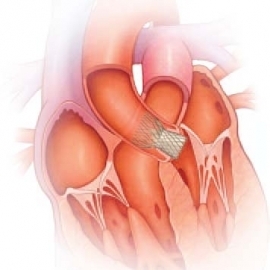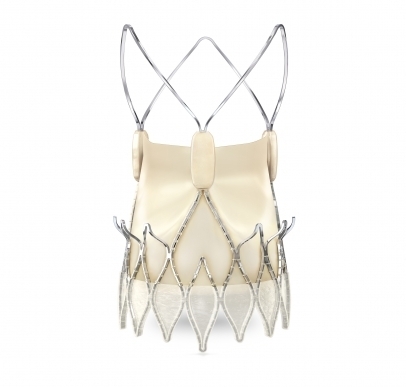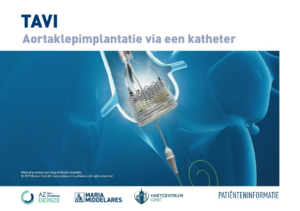Non-surgical aortic valve implantation
What is it?
What is it?Transcatheter aortic valve implantation
An aortic valve stenosis is one of the most common valve diseases. It is a constriction of the aortic valve (valve at the heart’s exit). The heart is forced to work harder to pump the blood to the rest of the body through a narrowed aortic valve.
If the patient's general condition allows, this may be treated surgically. If this is not possible, or if the surgical risk is too high, a percutaneous valve implantation may be proposed. For this procedure, a biological artificial valve is introduced through a catheter before being implanted in the area of the aortic valve. The catheter is usually inserted via an artery in the groin or shoulder.
What is the process?
What is the process?Preparation
You will be admitted to the Cardiology Department one day before the procedure. The nurse will accompany you to your room, where you will be able to make yourself comfortable. Blood draws will be performed that day, and an IV line will be placed. You may take your medication as agreed with the physician.
You will be given a surgical gown to wear. An electrocardiogram will be performed and you will receive additional preparation for the procedure.
The procedure is performed in the cardiac catheterisation room.

The procedure
You will take your place on the examination table. Adhesive electrodes are placed to monitor your heart rhythm. The anaesthetist takes care of the anaesthesia. You will be fully asleep during the procedure. You will be covered with a sterile sheet with a few cut-outs to allow for access to the blood vessels in the groin or shoulder, according to the anticipated access point.
A catheter will be placed at the site of the aortic valve to monitor the position. Various catheters will monitor your blood pressure and heart rhythm during the procedure. If necessary, these catheters will be left in place for a few hours or days after the procedure. As soon as the heart valve is correctly positioned, the catheters will be removed and blood loss will be checked.
You will wake up in Intensive Care, where you will stay for 24-48 hours.

What are the risks?
What are the risks?This procedure is only performed on people whose surgical risk is too high. A percutaneous aortic valve implantation is a less risky procedure, but complications cannot be ruled out. In order to minimise the chance of complications, we follow an extensive preparation and selection process.
Some possible complications include:
- bleeding from the puncture site
- need for a permanent pacemaker
- embolisation of plaque or a clot, which could cause stroke
- cardiac tamponade
- paravalvular leakage
- late-onset infection of the valve prosthesis
Results
ResultsRehabilitation usually goes smoothly, and you will be able to go home three to five days later. After the procedure, the aortic valve's resistance will return to normal.
Leaflet
LeafletSee the leaflet below for more information.
Only available in Dutch:

Niet-chirurgische aortaklep implantatie
DownloadCentres and specialist areas
Centres and specialist areas
Something wrong or unclear on this page? Report it.
Latest publication date: 13/08/2024
Supervising author: Dr. Provenier Frank





